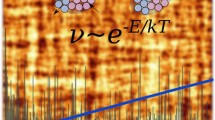Abstract
We analyze scaling and localization phenomena in the fracture of a random central-force spring lattice model with strong disorder by means of computer simulation. We investigate the statistical and topological properties of the developing damage pattern and the scaling behaviour of the threshold. Our observations show that from the beginning and up to the point of maximum stress, damage develops in a uniform manner, qualitatively like in a percolating lattice, but numerically different from random percolation. Beyond the maximum-stress point localization and anisotropy come into play, resulting in final crack formation. The fraction of broken bonds at which the lattice fails, as well as the strain corresponding to failure, scale with the lattice size via power laws. The roughness of the final crack scales as a power law of the crack length over three decades of lengthscale.
Similar content being viewed by others
References
Z.P. Bažant (1999) ArticleTitleSize effect on structural strength: a review Archive of Applied Mechanics 69 703–725 Occurrence Handle10.1007/s004190050252 Occurrence Handle0970.74065
C.S. Chang T.K. Wang L.J. Sluys J.G.M. Mier Particlevan (2002a) ArticleTitleFracture modeling using a micro-structural mechanics approach - I. Theory and formulation Engineering Fracture Mechanics 69 1941–1958 Occurrence Handle10.1016/S0013-7944(02)00070-X
C.S. Chang T.K. Wang L.J. Sluys J.G.M. Mier Particlevan (2002b) ArticleTitleFracture modeling using a micro-structural mechanics approach - II. Finite element analysis Engineering Fracture Mechanics 69 1959–1976 Occurrence Handle10.1016/S0013-7944(02)00071-1
T. Engøy K.J. Maløy A. Hansen S. Roux (1994) ArticleTitleRoughness of two-Dimensional cracks in wood Physical Review Letters 73 834–837 Occurrence Handle10.1103/PhysRevLett.73.834 Occurrence Handle1994PhRvL..73..834E
A. Hansen J. Schmittbuhl (2003) ArticleTitleOrigin of the universal roughness exponent of brittle fracture surfaces: stress-weighted percolation in the damage zone Physical Review Letters 90 045504.1–045504.4 Occurrence Handle2003PhRvL..90d5504H
H.J. Herrmann A. Hansen S. Roux (1989) ArticleTitleFracture of disordered, elastic lattices in two dimentions Physical Review B39 637–648 Occurrence Handle1989PhRvB..39..637H
H.-P. Hsu M.-C. Huang (1999) ArticleTitlePercolation thresholds, critical exponents, and scaling functions on planar random lattices and their duals Physical Review E60 6361–6370 Occurrence Handle1999PhRvE..60.6361H
S. Morel E. Bouchaud J. Schmittbuhl G. Valentin (2002) ArticleTitleR-curve behavior and roughness development of fracture surfaces International Journal of Fracture 114 307–325 Occurrence Handle10.1023/A:1015727911242
P.K.V.V. Nukala S. Šimunović S. Zapperi (2004) ArticleTitlePercolation and localization in the random fuse model Journal of Statistical Mechanics: Theory and Experiment. P 08001 1–23
A. Omeltchenko J. Yu R.K. Kalia P. Vashishta (1997) ArticleTitleCrack front propagation and fracture in a graphite sheet: a molecular-dynamics study on parallel computers Physical Review Letters 78 2148–2151 Occurrence Handle10.1103/PhysRevLett.78.2148 Occurrence Handle1997PhRvL..78.2148O
R. Riedinger M. Habar P. Oelhafen H.J. Güntherodt (1998) ArticleTitleAbout the Delaunay-Voronoi tesselation Journal of Computational Physics 74 61–72 Occurrence Handle10.1016/0021-9991(88)90068-X Occurrence Handle1988JCoPh..74...61R
M. Sahimi (2003a) Heterogeneous Materials I. Linear Transport and Optical Properties Springer-Verlag New York Occurrence Handle1028.74001
M. Sahimi (2003b) Heterogeneous Materials II. Nonlinear and Breakdown Properties and Atomistic Modelling Springer-Verlag New York
E. Schlangen E.J. Garboczi (1996) ArticleTitleNew method for simulating fracture using an elastically uniform random geometry lattice International Journal of Engineering Science 34 1131–1144 Occurrence Handle0900.73598 Occurrence Handle10.1016/0020-7225(96)00019-5
D. Stauffer A. Aharony (1992) Introduction to Percolation Theory EditionNumber2 Taylor and Francis London, Washington, DC Occurrence Handle0862.60092
W. Weibull (1939) ArticleTitleThe phenomenon of rupture in solids Proceedings of Royal Swedish Institute for Engineering Research (Ingeniors Vetenskaps Akademiens Handlingar) 153 1–55
Author information
Authors and Affiliations
Corresponding author
Rights and permissions
About this article
Cite this article
Malakhovsky, I., Michels, M.A.J. Scaling, localization and anisotropy in fracturing central-force spring lattices with strong disorder. Int J Fract 139, 343–357 (2006). https://doi.org/10.1007/s10704-006-0020-8
Received:
Accepted:
Issue Date:
DOI: https://doi.org/10.1007/s10704-006-0020-8




